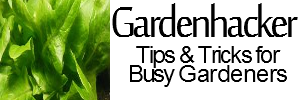
Early blight – photo credit: wikipedia.org
Early blight on tomato plants starts on the lowest leaves as dark spots, working it’s way up to eventually consume the whole plant. This fungus (Alternaria solani) overwinters on the debris in the soil, especially on the remains of the same or similar plants. Other plants are also susceptible to this fungus, including the close cousin potatoes, peppers, eggplants and even basil, especially the Genovese variety.
Preventive Procedures
- Crop rotation can minimize this problem along with the
- removal of all of the plant debris,
- purchasing disease free potato seeds
- tomato plants with the “A” or ASC” (Alternaria Stem Canker) to provide resistance from getting the disease (though many desirable varieties do not have this resistance)
- Watering in the morning or minimizing splash of water or soil onto the leaves
- Liberal mulching around the plants so no bare soil can get splashed onto the lower leaves
- Utilizing drip irrigation of various types to minimize splashing when watering
While preventative measures are worth the effort, what happens if you find this fungus has taken hold? There are several chemical sprays available, though as most people wish to remain as organic as possible (including ourselves), we will instead focus on these solutions.
- Physically removing the leaves from the lowest portion of the plant and remove from the garden area completely. Disposing of the material is recommended, since composting would only reintroduce the fungus. This will also increase the air flow around the plant, causing the morning dew to evaporate quicker (the fungus needs the moisture to begin it’s infection)
- In extreme cases, removing the soil is a possible solution, especially if there has been a reoccurance.
Organic options include
- copper hydroxide
- Copper Soap Fungicide
- Copper octanoate (Bonide
, “Ferti-Lome”
)
- Neem oil
Be sure to follow the directions exactly.
At the first sign of this disease, take action! You don’t want to spread to any of the rest of your plants, or your neighbors, since wind can transfer the fungus as well.
Check with your local agricultural extension too. There may be other wild plants in your area that harbor these diseases.
Subscribe to our newsletter – Be the first to receive GardenHacker updates! Article briefs right to your mailbox! Unsubscribe any time. We don’t spam (mailchimp hates spam!) Learn more…









Recent Comments